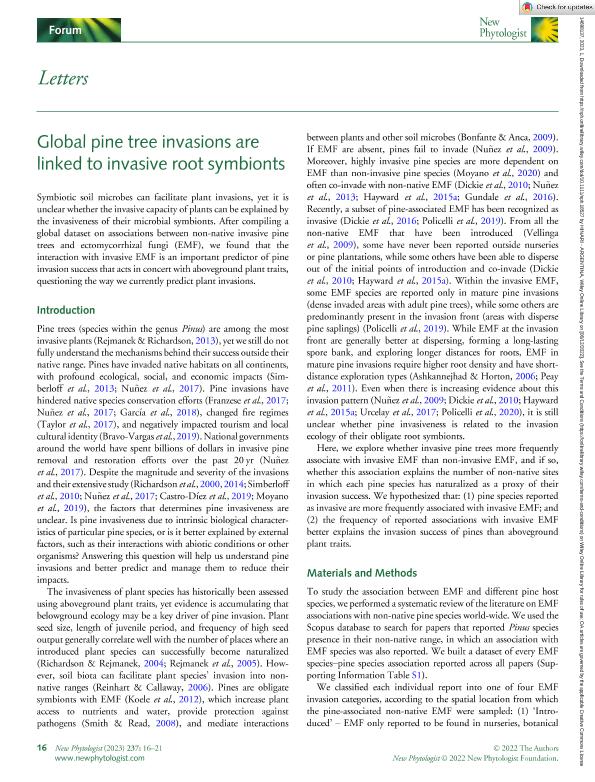Mostrar el registro sencillo del ítem
dc.contributor.author
Policelli, Nahuel

dc.contributor.author
Hoeksema, Jason D.
dc.contributor.author
Moyano, Jaime

dc.contributor.author
Vilgalys, Rytas
dc.contributor.author
Vivelo, Sasha
dc.contributor.author
Bhatnagar, Jennifer M.
dc.date.available
2023-11-13T12:30:17Z
dc.date.issued
2022-10
dc.identifier.citation
Policelli, Nahuel; Hoeksema, Jason D.; Moyano, Jaime; Vilgalys, Rytas; Vivelo, Sasha; et al.; Global pine tree invasions are linked to invasive root symbionts; Wiley Blackwell Publishing, Inc; New Phytologist; 237; 1; 10-2022; 16-21
dc.identifier.issn
0028-646X
dc.identifier.uri
http://hdl.handle.net/11336/217852
dc.description.abstract
Symbiotic soil microbes can facilitate plant invasions, yet it is unclear whether the invasive capacity of plants can be explained by the invasiveness of their microbial symbionts. We compiled a global database of one of the most widespread invasive non-native species on Earth ? pine trees and their major fungal symbionts, ectomycorrhizal fungi (EMF) ? and tested the hypothesis that the associations with invasive EMF increases the invasion success of pines. We found that successful pine species invasions are better explained by their association with invasive EMF than by aboveground plant traits that are typically used to explain plant invasiveness. Late-successional invasive EMF were most closely related to pine invasion success, implying that this subset of introduced EMF species might be key to sustain the invasion of their hosts. Our results suggest that the interaction with invasive microbial symbionts is an important predictor of plant invasion success.
dc.format
application/pdf
dc.language.iso
eng
dc.publisher
Wiley Blackwell Publishing, Inc

dc.rights
info:eu-repo/semantics/openAccess
dc.rights.uri
https://creativecommons.org/licenses/by-nc-sa/2.5/ar/
dc.subject
BELOWGROUND MICROBES
dc.subject
ECTOMYCORRHIZAS
dc.subject
INVASIVE FUNGI
dc.subject
PINUS
dc.subject
PLANT INVASIONS
dc.subject
PLANT–SOIL FEEDBACKS
dc.subject.classification
Ecología

dc.subject.classification
Ciencias Biológicas

dc.subject.classification
CIENCIAS NATURALES Y EXACTAS

dc.title
Global pine tree invasions are linked to invasive root symbionts
dc.type
info:eu-repo/semantics/article
dc.type
info:ar-repo/semantics/artículo
dc.type
info:eu-repo/semantics/publishedVersion
dc.date.updated
2023-11-10T14:34:41Z
dc.journal.volume
237
dc.journal.number
1
dc.journal.pagination
16-21
dc.journal.pais
Reino Unido

dc.journal.ciudad
Londres
dc.description.fil
Fil: Policelli, Nahuel. Boston University; Estados Unidos. Consejo Nacional de Investigaciones Científicas y Técnicas. Centro Científico Tecnológico Conicet - Patagonia Norte. Instituto de Investigaciones en Biodiversidad y Medioambiente. Universidad Nacional del Comahue. Centro Regional Universidad Bariloche. Instituto de Investigaciones en Biodiversidad y Medioambiente; Argentina
dc.description.fil
Fil: Hoeksema, Jason D.. University of Mississippi; Estados Unidos
dc.description.fil
Fil: Moyano, Jaime. Consejo Nacional de Investigaciones Científicas y Técnicas. Centro Científico Tecnológico Conicet - Patagonia Norte. Instituto de Investigaciones en Biodiversidad y Medioambiente. Universidad Nacional del Comahue. Centro Regional Universidad Bariloche. Instituto de Investigaciones en Biodiversidad y Medioambiente; Argentina
dc.description.fil
Fil: Vilgalys, Rytas. University of Duke; Estados Unidos
dc.description.fil
Fil: Vivelo, Sasha. Boston University; Estados Unidos
dc.description.fil
Fil: Bhatnagar, Jennifer M.. Boston University; Estados Unidos
dc.journal.title
New Phytologist

dc.relation.alternativeid
info:eu-repo/semantics/altIdentifier/url/https://onlinelibrary.wiley.com/doi/10.1111/nph.18527
dc.relation.alternativeid
info:eu-repo/semantics/altIdentifier/doi/http://dx.doi.org/10.1111/nph.18527
Archivos asociados
